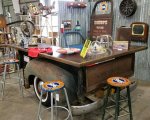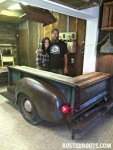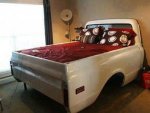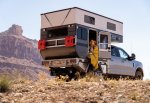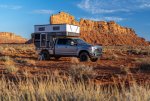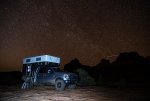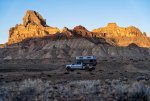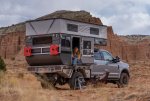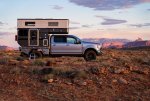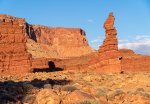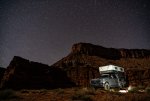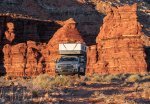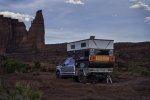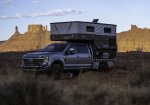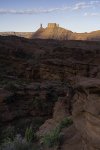That's all great information. Thank you! I'll add to the article when I have time. That Highway Products flatbed looks killer. I wasn't even aware of their product but I really like it.
Yes, the actual cab of the F250 is basically the same size as the F150, both of which are SuperCrew configuration. But, the flatbed provides WAY more living and storage space than the slide-in Raven, which is where we picked up the extra room. The flatbed tray also has a 15 gallon water tank, the underbed storage and rear drawer so much of what we were carrying in the cab of the F150 is now in the flatbed tray.
One of the main factors that played into my decision to build on a 3/4 ton platform instead of 1/2 ton was the extra strength and payload capacity of a 3/4 ton truck. The F150 was tapped out with the Raven on it. I can't imagine adding another 1,200+ pounds to it. It'd be scary. The F250 also provides more ground clearance and better approach/departure angles than our F150 did, so even though it's longer it will serve us better when traveling offroad.
You're welcome.
Other stuff I've learned in my HPI flatbed process ('19 F350 SuperCrew 6.75'bed 6.2L, HPI flatbed with crossframe tunnel box + 4underbelly boxes, ATO Aterra XL composite camper);
--What departure/breakover angles do you want from your setup? This will determine underbelly box heights and lengths.
--Where to put your spare if you don't keep it in the stock location? Surprisingly HPI hasn't done any tire swingouts on their flatbeds.
--HPI specifically has built a LOT of flatbed configurations (private individuals, municipalities/govt/fire/rescue, farmers/ranchers, miners, commercial/industrial, etc), and so they have a LOT of engineering plans to borrow ideas from. Means you don't have to pay the engineering costs if something has already been engineered.
--If the flatbed is full custom like HPI (or AlumLine--although ask Jon Burtt about his AlumLine experience, or Hillsboro, or CM, or maybe even AT Overland if they're offering custom--their setups are a mix of aluminum and composite boxes), then the sky is the limit as to how you configure everything. HPI engineers need to know stock susp or susp lift, stock tire size or upgraded. They can do crossframe/tunnel boxes for storage(popular is a storage box on driver side, open space for spare tire on pass side). They can add E-track or L-track to the box(inside or out). They can do angled end corners as shown, or 90deg end corners. They can do truck frame extensions so that you have a longer flatbed than your pickup bed was. There's a minimum thickness height to the entire flatbed (with HPI it's about 6-7"H), but if you need it taller than that, they can build it with taller sills. Under-belly boxes can be off-the-shelf boxes with 90deg edges, or angled like shown(more $$). They can add filler triangles to mimic a wheel well. They can build the flatbed deck with an actual wheel well contour as shown. They can add a rear winch as shown. Mudflap of all different heights, or no. Side steps that slide out, rear fixed steps, rope tie downs on the side as shown, small or large clearance lights as shown, all different finishes (paint to powdercoat as shown), different surfaces on the box faces (Gladiator dimples as shown), minimum faces/edges on the box construction so that you're maximizing the loading area, LED lights inside the boxes, shocks or cables or chains as shown for box doors, etc etc...so many options it can be overwhelming. So it's certainly quicker to go with something like a Norweld which is much more standardized. The Norweld water tank and rear drawer is a very nice feature. Based on the way HPI engineers their flatbed structure(horizontal/transverse beams), it's not easy to have an under-bed water tank, or rear drawer. Possible, but high engineering costs. I guess the wildland fire crews don't request it, so there's no previous engineering to borrow from.
--Lifetime warranty. Worth it IMHO.
--All made in USA, in southern Oregon. Impressive facility which you can tour (even more impressive is their boat division;
https://pavati.com).
--It's a long process to nail down exactly what you want/how you want it, especially if you're OCD and want to maximize your $. Be patient. I've been at my HPI plan for 6mos easy, refining and refining--have a great sales guy (Aaron Taylor, head of fire/rescue dept). 5-6mos to build from when order was placed.
That HPI flatbed is pretty much the extreme. Guy named Chuck owns it, he does defense/weapons contracting for the gov't, so has the $$$ for something like this.
While it'd be ideal to have a dual purpose flatbed (camper on, and then remove the camper and use the flatbed for hauling material), this is challenging, at least in the configuration HPI is building for me. They need to engineer backing plates into the flatbed deck for the camper. But the access points for the 4 camper tie downs will be behind the underbelly boxes. So, to retain HPI's legendary box sealing (keeping dirt/dust/water out), I can't easily have camper tie down access holes in the tops of the boxes, as the boxes wouldn't seal 100%. I'd need to remove the boxes, access the tie downs, then reinstall the boxes and re-seal them to the flatbed. I'm sure they could engineer a solution, but for the $$ to do so, and the amount of times I'd use the flatbed sans camper, it's not worth the cost IMHO. So, decide if this feature (of camper off/on often) is something you'd REALLY use.
Makes perfect sense on upgrading from the F150 to F250 based on payload first, then moving from slide-in to flatbed for more space inside the camper, and more utility out of the camper(slide-in camper has wasted space due to the truck bed sides prohibiting useful storage).
Thanks for letting us follow along!

